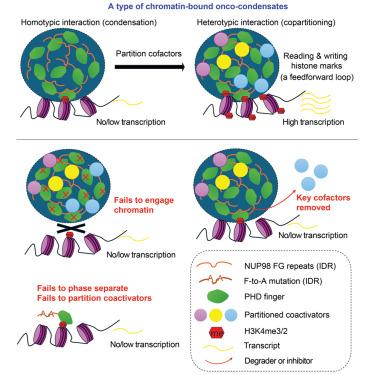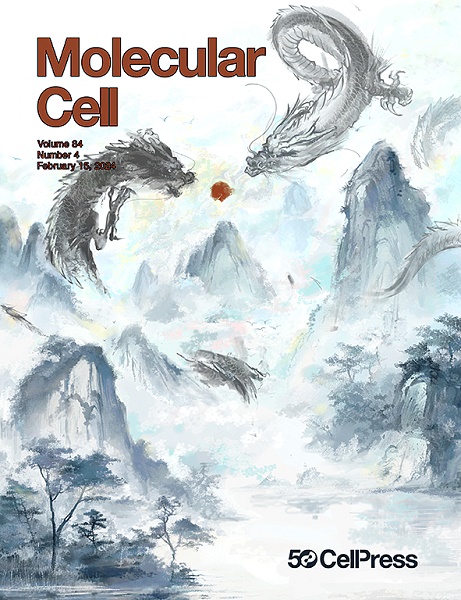The phenylalanine-and-glycine repeats of NUP98 oncofusions form condensates that selectively partition transcriptional coactivators
IF 14.5
1区 生物学
Q1 BIOCHEMISTRY & MOLECULAR BIOLOGY
引用次数: 0
Abstract
Recurrent cancer-causing fusions of NUP98 produce higher-order assemblies known as condensates. How NUP98 oncofusion-driven condensates activate oncogenes remains poorly understood. Here, we investigate NUP98-PHF23, a leukemogenic chimera of the disordered phenylalanine-and-glycine (FG)-repeat-rich region of NUP98 and the H3K4me3/2-binding plant homeodomain (PHD) finger domain of PHF23. Our integrated analyses using mutagenesis, proteomics, genomics, and condensate reconstitution demonstrate that the PHD domain targets condensate to the H3K4me3/2-demarcated developmental genes, while FG repeats determine the condensate composition and gene activation. FG repeats are necessary to form condensates that partition a specific set of transcriptional regulators, notably the KMT2/MLL H3K4 methyltransferases, histone acetyltransferases, and BRD4. FG repeats are sufficient to partition transcriptional regulators and activate a reporter when tethered to a genomic locus. NUP98-PHF23 assembles the chromatin-bound condensates that partition multiple positive regulators, initiating a feedforward loop of reading-and-writing the active histone modifications. This network of interactions enforces an open chromatin landscape at proto-oncogenes, thereby driving cancerous transcriptional programs.

求助全文
约1分钟内获得全文
求助全文
来源期刊

Molecular Cell
生物-生化与分子生物学
CiteScore
26.00
自引率
3.80%
发文量
389
审稿时长
1 months
期刊介绍:
Molecular Cell is a companion to Cell, the leading journal of biology and the highest-impact journal in the world. Launched in December 1997 and published monthly. Molecular Cell is dedicated to publishing cutting-edge research in molecular biology, focusing on fundamental cellular processes. The journal encompasses a wide range of topics, including DNA replication, recombination, and repair; Chromatin biology and genome organization; Transcription; RNA processing and decay; Non-coding RNA function; Translation; Protein folding, modification, and quality control; Signal transduction pathways; Cell cycle and checkpoints; Cell death; Autophagy; Metabolism.
 求助内容:
求助内容: 应助结果提醒方式:
应助结果提醒方式:


